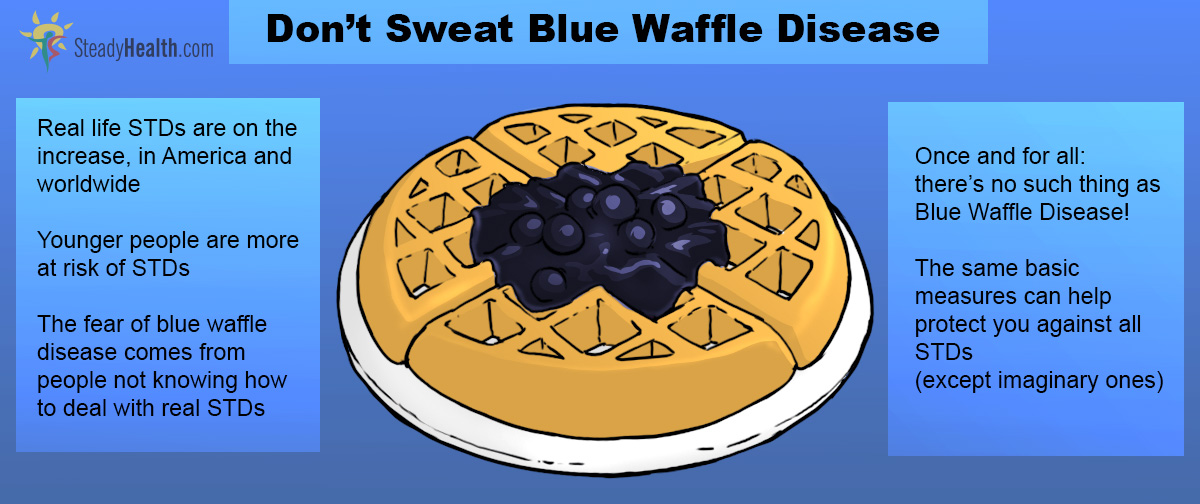Table of Contents
Blue Waffle Disease has been on America’s lips, so to speak, since at least the year 2010. It got a shot in the arm when New Jersey city councilwoman Kathy McBride addressed a city council meeting and asked what was being done about the issue. For several years now, we've been hearing rumors about an STD which is called "blue waffle disease." However, unsurprisingly, not everything you see on the internet is correct. Yes, it's true that STDs can be dangerous and that it's very important to take steps to be safe. You won't, however, have to worry about so-called blue waffle disease.
So, what exactly is the real story behind Blue Waffle Disease, and why don't you have to worry about it? Well, let's take a look.
Let’s Look Into A Little Background
STDs are on the rampage among young people — especially recently. Sure, we all probably expect the young, and often irresponable and impuslive, teenagers to be more likely to have more sex with more partners than people who are aged 32-year olds like me, but after decades of sexual health teaching, we expect them to at least know how to protect themselves from the dangers of casual sex. We’d be wrong: It’s hard to attribute the rise to any specific cause, much as true believers on the right or left might wish, but the fact is that 68 percent of Chlamydia cases in the USA in 2014 were in people aged 15-24. The more serious Gonnorrhea and Syphilis are also much more prevalent among this age group, reaching their peak in 20-24-year-olds.
Real STDs aren’t actually on the increase. They rose, then fell, rose again and have now been declining since about 2011 — but they are far more common among the young than they should be. It’s hard to think that the cause is a lack of knowledge about sexual health. Despite decades of instruction, potentially lethal myths about sexual health and disease persist.
In Australia, a wealthy country with plenty of sex advice including classroom sex education, a 2013 survey found that 13 percent of high school students "never" used a condom when they had sex. Never. Only 43 percent — less than half — said they always used a condom. If the 67 percent of Australian young people who thought that using condoms was something to be casual about were a little better informed, the HIV infection rate among Australian 15 to 19-year-old males might not have more than doubled in the last five years.
One Thing They Do Know About, Though, Is Blue Waffle Disease
Never heard of it? Until about six months ago, neither had I. But after I saw it mentioned once, I found it so improbable that I did some searching. And it was everywhere!
Opinion is divided between those who regard blue waffle disease as a single ailment and those who think of it as a combination of the symptoms of several interacting sexual diseases. For instance, "Chris Attakk" says:
See Also: Sexually Transmitted Diseases: Testing And Prevention
"So, you are correct that it isn’t its own disease. On the contrary, its actually the make up of several sexually transmitted diseases. Gonorrhea is what causes some of the coloring and smell, yeast infection makes the smell worse, herpes causes the lumps and swelling(since there is already infection from other STDs, the herpies [sic] are prominent all the time and Dont [sic] go away like they normally would if infection wasn’t present.) Also, blue waffle also consists of syphilis as well. Causing more sores and unsightly rashes. So no, blue waffle isn’t a disease, but is made up of multiple others and blue waffle is the result of all them mixing together."
- www.cdc.gov/std/
- www.acys.info/facts/sexual_health
- http://www.snopes.com/medical/myths/bluewaffle.aspMind map by SteadyHealth.com
- Photo courtesy of Nicola since 1972 via Flickr: www.flickr.com/photos/15216811@N06/8403389430


